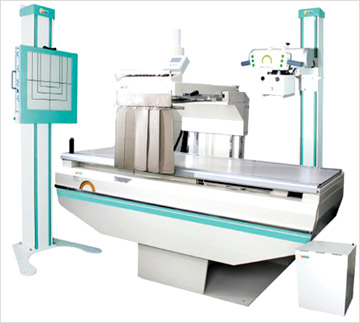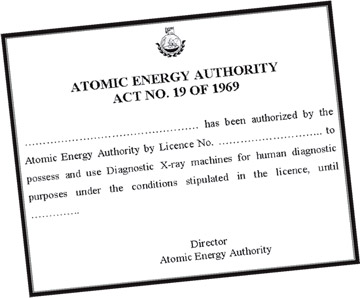|
Doctors rely solely on X-ray or scan to diagnose
ailments:
How safe are private X-ray centres?
By Kurulu Kariyakarawana
|

Chairman AEA Dr. Ranjith Wijeyawardena
|
Radiography and scanning are key features in the modern medical
world, to diagnose an illness or identify a defect in a body part.
Unlike in the good old days doctors now rely solely on an X-ray or a
scan result to diagnose one's ailment and prescribe medication.
Getting an X-ray is simple nowadays which can be obtained at any
state or private hospital in the country or in most medical centres in a
town that has such facilities.
It has grown to be a lucrative domestic business in the outstation
where centres are set up in houses in the absence of proper medical
centres or due to the scarcity of hospitals in villages.
Anybody who has an X-ray machine and an atom of skill in radiology
could simply open an X-ray centre almost anywhere, even in a room in a
house or in a roadside boutique. One could easily get an X-ray done in
any of these centres just for Rs.400, within minutes. But, how
appropriate and safe is it to get an X-ray at these places and what is
the quality of the radiography, are important questions.
|

An AEA official checking an X-ray machine |
There are guidelines set to carry out a proper X-ray centre
authorised by a licence issued by the relevant authorities. The licence
is issued only if proper standards of the trade are maintained, and if
not, it is an unauthorised X-ray centre which is not only illegal but
also hazardous to health.
The competent authority in charge of licensing X-ray machines or
centres is the Atomic Energy Authority. It is responsible for the
constant monitoring of X-ray machines or scanners used by hospitals,
medical centres and even domestic X-ray parlours to determine the safety
of the public who use it.
Chairman Atomic Energy Authority (AEA) Dr. Ranjith Wijeyawardena told
the Sunday Observer that a special licence has to be obtained to
operate, possess or import a General Radiography Machine or an X-ray
machine.
There are four modalities of machines that require a licence to
operate in Sri Lanka, namely, General Radiography Machine Computed
Tomography Scanner (CT scanner), Mammography Scanner, Dental X-ray
Machine and Fluoroscopy Machine.
According to the Atomic Energy Authority Act No 19 of 1969, it is a
punishable offence to operate or carry out an X-ray centre without a
licence. A heavy fine or a prison sentence can be imposed on offenders
who run unauthorised X-ray centres.
Deputy Director (Medical Applications) Radiation Protection and
Regulations T H S Shantha said a licence is issued for a two year
period. Before issuing a licence the AEA conducts a field study of the
building and environment of the place where the machine will be set up.
|

CT Scanner |
They will first check whether the chamber meets the Radiation
Protection Requirements such as whether the walls are thick enough and
the doors and door frames are shielded with lead sheets to prevent
radiation penetrating through them. It would be more suitable if the
room does not have any windows or ventilation grids.
Then, they check the performance of the machine to ascertain whether
it meets the required standards. Old and damaged machines could not only
leak radiation but also generate a radiograph with poor picture quality
which would not give the correct defect of a body part for a correct
diagnosis.
Thirdly, the qualification of the person who operates it will be
checked, to ensure whether he is a professional radiographer or a newly
qualified university graduate with the necessary qualifications.
The AEA maintains a database of X-ray licence holders including state
and private centres. If it is a big hospital a single licence is issued
to the head of the institute regardless of the number of X-ray machines
they have. For example, the National Hospital Colombo has about 40 X-ray
machines but the licence is issued to its Director.
At present there are about 400 registered licence holders and over
800 X-ray machines being used in Sri Lanka. However, these figures could
differ as there are non registered unauthorised X-ray machines being
operated at the same time.
The AEA could make surprise visits to these centres from time to time
to check their functioning. Specially trained Inspectors carry out
quality tests even at the time of the renewal of licence. They would
check for any hazardous radiation leaks in the centre and the quality of
the picture. If there are any problems the licence would not be renewed
and action will be taken against them.
With the issuance of the licence a special certificate is given to be
displayed in the form of a notice at the entrance of the specific X-ray
centre, which is a guarantee by the AEA that it is an authorised centre,
safe to obtain an X-ray.
All authorised centres managed by hospitals, private medical centres
and even domestic parlours display this certificate.
|

General Radiography Machine |
Dr. Wijeyawardena said it is the responsibility of the public to
check for the certificate before they obtain an X-ray from a private or
domestic centre to ensure that it is a safe place. Especially in rural
areas one can find many X-ray centres set up in houses as a domestic
business. There has been a number of instances reported about centres
operating without a licence.
|

Licence Certificate |
If a centre operates without a licence it means it is not guaranteed
as a safe place to obtain an X-ray. In other words it is a hazardous
place for the humans, that has radiation leaks.
The chairman said, "bad images could affect the doctor's diagnosis on
an illness. An incident was reported where an X-ray was ordered to be
taken for a stomach ailment. But the image showed nothing unusual about
the patient's stomach, although the pain persisted. The doctor then
ordered to take another X-ray at a different place, which showed a
defect in the patient's stomach. Hence, the poor picture quality of the
unauthorised centre gave a wrong report."
The Chairman advised doctors to use X-ray as a last option to
diagnose a patient's illness. Some doctors, even without having a proper
examination ask the patient to obtain an X-ray. Even a few seconds of
exposure to radiation is a risk.
Taking many X-rays could badly damage the health of a person causing
long term illnesses such as cancer, he said.
*********
X-ray
X-ray or X-radiation is a form of electromagnetic radiation
discovered by a German physics professor Wilhelm Conrad Rontgen in 1895.
He found that although an X-ray could pass through the human tissue, it
cannot pass through bone or metal.
X-ray photons carry enough energy to ionise atoms and disrupt
molecular bonds. This makes it a type of ionising radiation and thereby
harmful to living tissue.
A very high radiation dose over a short period of time causes
radiation sickness, while lower doses can give an increased risk of
radiation-induced cancer. In medical imaging this increased cancer risk
is generally greatly outweighed by the benefits of the examination.
********* |


